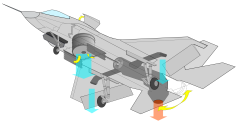- There should be a distinction made between WS-10B and WS-10D/B-3 (144 kN). After the core refresh in 2022 they're very different animals.
- WS-10C also went through a core refresh around the same time and I think WS-10C (late) is in the 150-155 kN range (if you're dead set on one number I'd say 150 kN, corresponding to the F110-GE-134 and "scratching the levels of old WS-15 rumour")
- WS-10C2 should be around the levels of the "fully realised WS-15 pre-revamp" at 160 kN ish? I doubt at the original YWH-30-27 core though at 175 kN (GE did propose a 178 kN F110 VCE variant but I doubt the C2 is one).
- Allegedly there's WS-15, WS-15A, and WS-15B too. But nothing much other than "they exist." And I think the current WS-15 (whatever the suffix is, A/B/X) should be 175+ kN based on the old goal from the YWH-30-27.
- The production WS-19 should be around 118-127 kN, leaning towards 127 kN.

